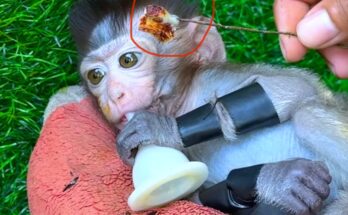High fever in monkeys is not just a sign of illness; it can be a life-threatening condition if not addressed promptly. Monkeys, particularly those in captivity—whether in zoos, research facilities, or rescue centers—require close monitoring for signs of illness, especially fever. Preventing high fever in monkeys starts with proactive healthcare, environmental management, and timely veterinary intervention.
Understanding Fever in Monkeys
A fever in monkeys, as in humans, is typically a symptom of an underlying issue such as infection (viral, bacterial, or parasitic), heat stress, or inflammation. The normal body temperature of a monkey ranges between 37°C and 39°C (98.6°F to 102.2°F), depending on the species. Any significant rise may indicate a systemic problem.
1. Regular Health Monitoring
One of the most effective ways to prevent high fever is through routine health assessments. Caretakers should regularly monitor body temperature, appetite, behavior, and physical condition. Non-invasive digital thermometers, behavioral observation, and routine veterinary check-ups help detect early signs of illness before a fever becomes severe.
2. Vaccination and Parasite Control
Vaccination plays a crucial role in preventing viral infections that can cause fever, such as measles or simian hemorrhagic fever. Parasite infestations, both internal (e.g., roundworms) and external (e.g., mites), can also lead to fever. Regular deworming schedules and external parasite treatments significantly reduce these risks.
3. Stress Reduction and Environmental Enrichment
Stress is a major contributor to weakened immunity in primates. Enclosures should be designed to reduce psychological stress and include adequate space, naturalistic features, and social groupings that mimic wild behaviors. Enrichment activities like puzzle feeders, climbing structures, and foraging opportunities keep monkeys mentally and physically stimulated, boosting overall health.
4. Optimal Nutrition and Hydration
Malnutrition or dehydration can compromise a monkey’s immune system, making them more susceptible to infections. A balanced diet tailored to the species, rich in fruits, vegetables, proteins, and essential vitamins, supports strong immune responses. Access to clean, fresh water at all times is non-negotiable.
5. Temperature and Climate Control
Monkeys are sensitive to temperature fluctuations. High ambient temperatures can cause heatstroke, leading to dangerously high fevers. Enclosures should be equipped with proper ventilation, shade, and climate control systems to maintain a stable environment. Misting systems and water features can help cool primates during hot seasons.
6. Immediate Veterinary Attention
When signs of fever appear, early diagnosis and treatment are essential. Common treatments include antipyretics (fever reducers), fluids to prevent dehydration, and antibiotics or antivirals if an infection is detected. Blood tests and imaging may help identify underlying causes quickly.
Final Thoughts
Preventing high fever in monkeys is not just about emergency response—it’s about daily commitment to their overall well-being. Through comprehensive health monitoring, stress reduction, and professional veterinary care, caregivers can minimize the risk of fever and ensure that these intelligent, sensitive animals thrive in their environment.
By adopting these preventive strategies, we not only reduce the occurrence of high fever in monkeys but also promote a higher standard of animal welfare and disease prevention across captive and wild populations alike.


